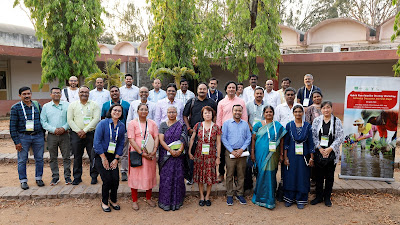INDIAN INSTITUTE of RICE RESEARCH, Hyderabad (05 April 2024) — Increase the yield of hybrid rice to 25 percent greater than inbred varieties. This is the challenge that hybrid rice scientists from the International Rice Research Institute (IRRI), its National partners, and the private sector must address for South Asian farmers to adopt rice hybrids. The call emerged during the Hybrid Rice Adoption Strategy Workshop that happened during the South Asia Advancement meetings that the IRRI Rice Breeding Innovations (RBI) Department facilitated. The activity took place in the IIRR campus, a NARES partner of IRRI South Asia under Dr. Vikas Kumar Singh, RBI South Asia Breeding lead.
Following the OneRice Breeding strategy implemented by RBI, farmers prefer a grain yield of greater than 25% from much stable hybrid rice lines compared with their parent lines, with multi-stress breeding more superior than ideal parental lines that match the market needs of high insect pest- and disease-resistance and abiotic stress tolerance. Achieving the genetic gains in the different inbred breeding programs (early, medium, and late maturity) that overlaps with the hybrid rice breeding program can be fully maximized.
The group must consider some critical issues, such as a unified focus of the industry stakeholders, sufficient supply of seeds at reasonable costs, and higher yield advantage over other rice varieties, according to Dr. Hans Bhardwaj, IRRI-RBI research director and head. Addressing these concerns are the chief tasks the working groups will endeavor this year.
Diversification of the rice female parent is also an important issue, Dr. Sankalp Bhosale, IRRI-RBI deputy head, delved into, emphasizing having a better source by developing new CMS lines targeting the important market segments. He also stressed the need to address the issue of heterosis, suggesting the group to have a strategy parallel to assured marketability. Specifically, Bhosale stated having a broad market for hybrid rice, which should have a greater than 25 percent yield advantage over open-pollinated varieties (OPVs). He encouraged the NARES stakeholders to strongly support the private sector with immense government support, mentioning the Philippines as an example of a robust subsidy program from the government on hybrid rice in-house breeding.
Dr. Jauhar Ali, IRRI-RBI Hybrid Rice lead, updated the group on the accomplished tasks from last year’s pilot workshop and created four working groups to develop concrete strategies and action plans to address the key challenges and constraints in the adoption of hybrid rice technology. He tackled issues such as market demands and increasing the area of hybrid rice seed production in the region. He also emphasized developing a road map for the group to deal with all the concerns one step at a time.
Updates on policy, funding, and advocacy came from Dr. Shaik Meera (Director, ICAR-ATARI), who stated a need for a paradigm shift in hybrid rice policy on the federal and national levels. It can be more effective to review successful hybrid rice policies from China, Vietnam, and the Philippines. On subsidy, Dr. Meera encouraged the group to influence policymakers more with strengthened participation of the public and private sectors in policy review or development. ”We should move out from the micro and household economic level and look at the macro-economic indicators to have more influence on the policy,” he added.
Dr. S. Manonmani, professor and head of the Rice Department of the Center for Plant Breeding and Genetics at Tamil Nadu Agricultural University, discussed capacity building and awareness. She indicated the need for certification courses to train students to become seed producers and help them get jobs in the industry. She suggested private companies sponsor students for such training.
As a way forward, the group noted all given recommendations in developing a road map, prioritizing key areas for an 8.5% increase in cultivation area in India, a female parent diversification for productive rice lines, and both the private and public sectors are united in pursuing above recommendations, acquiring massive government support. The group will continuously meet every quarter. The strategies developed from the workshop will be collected, and a booklet will be created to serve as the group’s guide.
Next year, the group will meet again at the South Asia Advancement meeting, which will coincide with the All India Coordinated Rice Improvement Project (AICRIP) meeting.
###
Learn more about IRRI (www.irri.org) or follow us on social media and networks (all links down the right column).





No comments:
Post a Comment